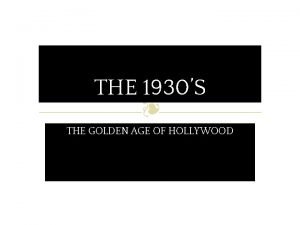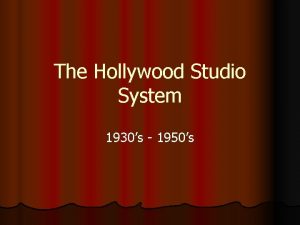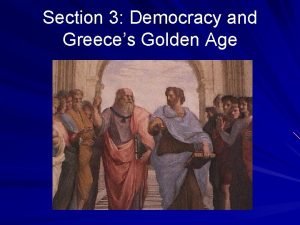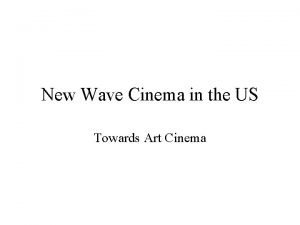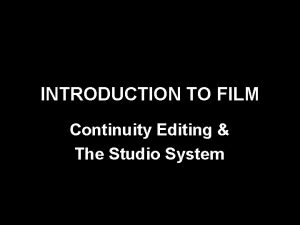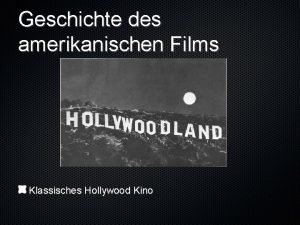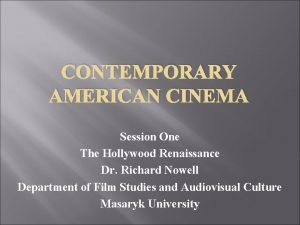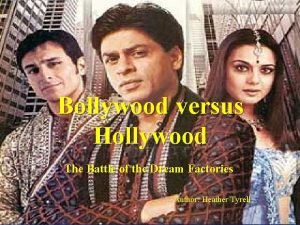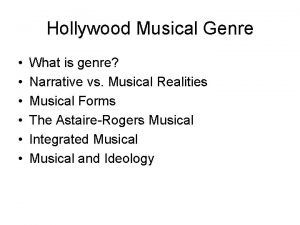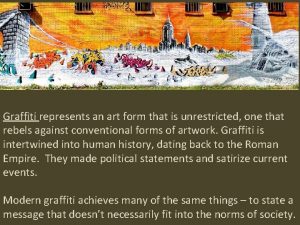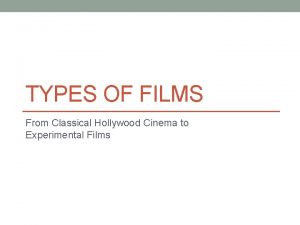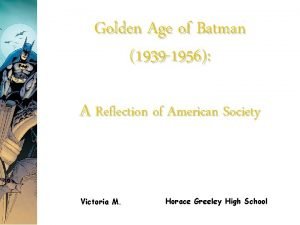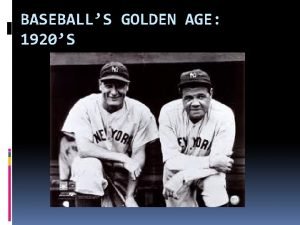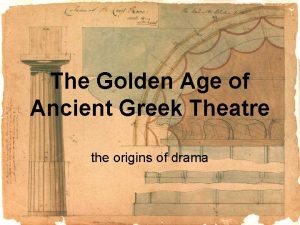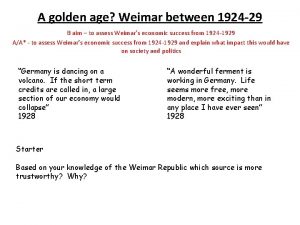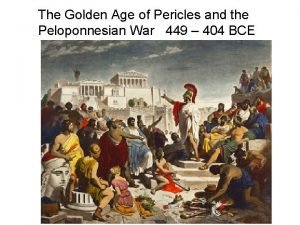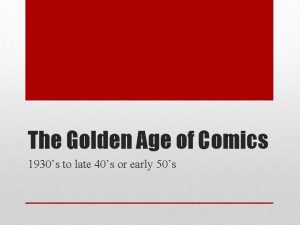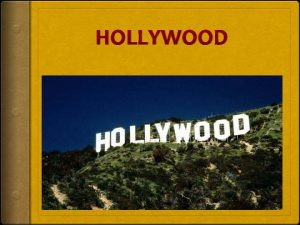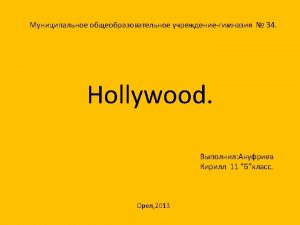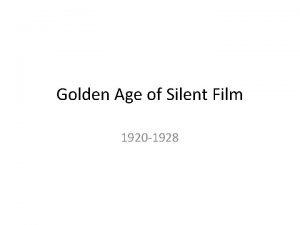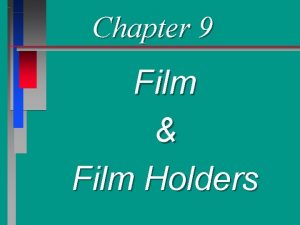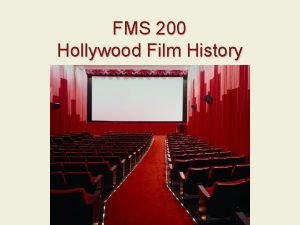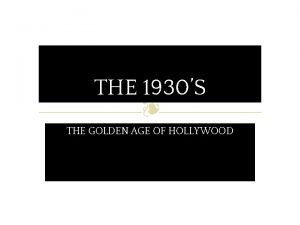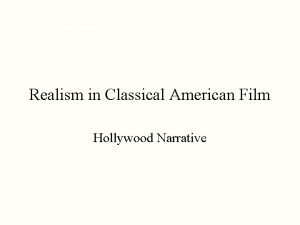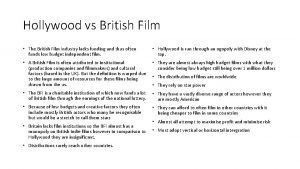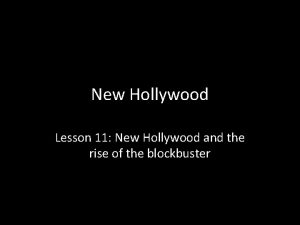Film History Early Hollywood and the Golden Age





















































- Slides: 53

Film History, Early Hollywood, and the Golden Age of Film A Brief History of Hollywood, Chance, and Dreams

Edison’s “Black Maria” Studio § “America’s First Movie Studio” in West Orange, New Jersey § The first photographed image on movie film was Fred Ott’s Sneeze (late 1800’s) § Other films were of acrobats, music hall performances, and boxing matches

Motion Picture: A New Invention § The first camera to capture moving pictures was called the kinetograph (1888). § The kinetograph led to the development of the kinetoscope, which was a coin operated viewing machine. This device worked for a single user at first and eventually projected images onto a screen for a larger audience.

Motion Picture: A New Invention So the difference between the two is… • The kinetograph came first (1888) and was an invention that ‘captured’ motion (i. e. more than just a still photograph) • The kinetoscope came second (middle 1890’s) and was a device that allowed you to view the captured motion (it evolved to eventually project the film on a screen).

Fred Ott’s Sneeze (1894) Otherwise known as “Edison Kinetoscopic Record of a Sneeze”

The Kinetograph and Kinetoscopes played fifty-foot sections of film (about 30 sec. )

The First Films The first films were crude movies. In the 1890’s, they were shown in penny arcades. These arcades later became known as Nickelodeons.

A Side Note… This wasn’t just occurring in America. The Lumiere brothers were inventing moving pictures and how to project them in France just like Edison was in America.

Nickelodeons § A nickel bought an hour of short films § Nickelodeons were extremely popular in poorer neighborhoods § This type of entertainment appealed primarily to the new wave of immigrants November 30, 1907

Early Entertainment Caste System Saloons Nickelodeon Burlesque Vaudeville Ziegfeld Follies “Theater” Opera

A Few Definitions § Burlesque: A satire or comedy of live performance, performance art, and adult entertainment generally using/relying on sex/sexual innuendos. § Vaudeville: A combination of separate, unrelated acts, including musicians, dancers, comedians, trained animals, magicians, one acts, etc… (think of the NV variety show) § Ziegfeld Follies: A series of elaborate theatrical productions on Broadway in New York City from 1907 until 1931 (later a radio show and a movie). Not as exclusive as the traditional Broadway theater productions or opera.


Burlesque § A satire or comedy of live performance, performance art, and adult entertainment generally using/relying on sex/sexual innuendos.

Vaudeville § A combination of separate, unrelated acts, including musicians, dancers, comedians, trained animals, magicians, one acts, etc… (think of the NV variety show)

Ziegfeld Follies

Motion Pictures Get A Plot (and Editing) • Edwin S. Porter – An early film pioneer who worked for Edison’s company – He was instrumental in changing the use of moving pictures from simply just filming “things” to using it to tell a story. It’s a very basic idea but one Edison and others hadn’t considered up till this time. – The Life of An American Fireman (1903) • How is this film different from the clips we’ve viewed so far? – The Great Train Robbery (1903) • The archetypal “Western” • One reel long • Immensely popular at Nickelodeons, financially established film as a commercial industry.


New Jersey/New York: Hub of American Movie Industry § In the early days, New York and New Jersey were the center of the film industry. § The problem was, it was overshadowed by Broadway and Edison’s Trust had many patents that were rigorously defended by law. § Also, Broadway stars refused to “degrade” themselves in films

Film’s First Monopoly • Formed in 1908, the Motion Picture Patents Company (MPPC) attempted to monopolize the new invention and industry of film. • It was nicknamed “The Edison Trust” • Edison owned many of the patents necessary to make a motion picture, and had an exclusive deal with Kodak, the main distributor of raw film. The monopoly was challenged, and the Edison Trust defeated in court. This led to the establishment of… The Studio System

Founders of Dominant Film Companies Paramount Pictures • Founded by Adolph Zukor in 1912 • Instituted the practice of Block Booking Universal Studios • Founded by Carl Lammle in 1912 • Movie productions were of high quality, funded by Lammle himself • Studio was open to the public as a tourist attraction MGM-Leow’s • Founded by Marcus Loew in 1924 • Consolidated Metro Pictures (1916) and Goldwyn Pictures (1917) with Loew’s Inc. Fox Film Corporation • Founded by William Fox in 1915 • Bought the Movietone Sound System in an effort to record sound with film

The New Studios’ Vision They wanted to increase audiences • Their Solution? – Use well-publicized stars – Show feature-length films – Provide luxurious theaters

The Rise of Cinema • The popularity of film skyrocketed between the years 1909 and 1921. This was due to: More Theaters Longer Movies More Serious Subjects Greater Revenue The Loews Theatre chain hired nationally-known theater architect John Eberson, who designed this 1928 theater in a Spanish-influenced style called Churrigueresque.


D. W. Griffith Moves West § A Hollywood pioneer, who filmed The Birth of A Nation (1915) – the first feature length American film § Emphasized action and drama with westerns and crime movies § The Birth of A Nation was the highest grossing movie of all time for quite a while but also very controversial!

Hollywood, California § Hollywood was initially an agricultural community § The area is named for the California Holly there § It was a small, untouched settlement, connected to Los Angeles by a trolley car track (Hollywood Boulevard) and an aqueduct § D. W. Griffith came to Hollywood, and it was discovered as a film location

Why Hollywood? • Moving the California and far away from Edison’s base helped ease legal issues and provided more opportunity to get into the film business. • Provided a much better natural setting than New York/New Jersey. – Open land – Spectacular locations to film – Much better climate than East Coast • Labor and land was much cheaper than in the built up areas in and around New York City.

A Conservative, Agricultural Town • Town ordinances prohibited the sale of alcohol, and allowed cattle drives through the center of town • At one point, The Hollywood Hotel had a sign on it’s door that read “No Dogs Allowed, No Actors Allowed” • The industry took advantage of the area and the workers. For instance… – With one movie, the director spilled oil over intersections for shots in his films of cars crashing. As soon as the shooting was done, they just left the mess behind. – One director released a lion in a crowd of extras in order to film their reaction.

The Rise of the Studio System • By the mid-1920’s, MGM, Paramount, Universal and Fox had an overwhelming share of the film industry • Each of these four studios produced a new major feature every week (that’s an amazing pace compared to the studios today) • They also produced 4 out of every 5 movies made • Their dominance was worldwide: 80% of foreign screens showed their films

Casting Call

Charlie Chaplin (1889 -1977) § Charlie Chaplin is still one of the most famous film actors of all time § Chaplin was born in England; his parents were stage entertainers § His first stage experience was when he was a child. His mother, struck with laryngitis, was booed off of the stage. Charlie stepped out in front of the rowdy crowd alone and began to sing.

Keystone Studios § Chaplin founded Keystone Studios § Chaplin invented “The Tramp, ” the character he would become famous for… – baggy pants – tight coat – derby hat – large shoes – small mustache § The character was retired after Modern Times, the “last silent film”

Chaplin Look-alike Contest Legend has it, Charlie Chaplin entered a Charlie Chaplin look-alike contest in 1915 as a joke. He came in third.

Charlie Chaplin • Watch the clips from some of Chaplin’s films and evaluate to what you think of Chaplin’s humor. How would you describe his methods? Do you think he’s funny? Does it hold up in 2019?

Hollywood’s Financial Importance • The film industry soon became America’s 5 th largest industry – Movie studios grossed over $700 million each year • This all changed with the invention of SOUND – Hollywood tried to resist this invention because in the mid-1920’s they were enjoying a commercial and artistic peak.

The Invention of Sound § In 1877, Thomas Edison invented the first sound recording device – the phonograph § Sound recording was a mechanical process; there was no electricity involved § It was incredibly difficult to amplify sound § It was nearly impossible to sync sound with motion pictures

Sound Wave Complications § Sound disrupted the current filmmaking process § Sound was expensive § Implementation of sound required expensive speakers § Additionally, all silent films could be shown in any country easily through simple dialogue card translations.

The Warner Brothers’ Gamble • The small studio tried to make it big, and took a risk investing in sound.

Warner Brothers’ Risk § Recorded sound to avoid paying live performers § Produced music on discs that are synchronized with the movie reel § In 1926, the studio released Don Juan with musical accompaniment.

Warner Bros’ Problem § The invention worked but there was no true difference between musical accompaniment recorded on tape or performed § Radio, which posed a growing threat, contained dialogue § Film needed the combination of dialogue and music. § This gamble paid off with the release of The Jazz Singer on October 26, 1927. • The first film to include spoken dialogue • 88 minutes long • Finally placed WB among the top film companies

The Jazz Singer

The Effects Of The Jazz Singer § By summer 1928, 300 theaters were set-up to show the first crude talkies § By late 1929, everyone but Garbo and Chaplin had either talked on screen or had to quit the business § Hollywood began to go through a technical and economic revolution § Sound intensified appeal of movies § Sound enabled Hollywood to ward off the competition from radio § Without sound, the industry may not have weathered The Great Depression

Hollywood and The Depression § There were many changes for Hollywood: Many actors and musicians became unemployed By 1932, half of the major studios were financially threatened § One half of the nation’s theaters were shut down § Studios slashed salaries and production costs § In desperation, the film studies started to focus on…

Out of desperation to sell tickets to keep from going bankrupt, producers begin to ignore the censorship codes • Violence (and sex, more on that later) flourished in films – The addition of dialogue added to the allure of the gangster. – Gangsters became folk heroes by defying authority and achieving the “American Dream” (though the gangster never truly ‘won’ – he invariably would die, get arrested/thrown in jail, etc…) – 50 gangster movies made in 1931 alone


Movies: Uncensored “What could I do? He's my boss and I have to earn my own living. ”


Mae West • Delighted audiences with her attitude about sex – rebelled against the traditional female expectations and roles. • **You. Tube: “A Tribute to Pre-code” • However, she (& many others) would become a victim of the new censorship codes. . .

The “Legion Decency” Legion of of Decency Oh, §the immense amount of good that the motion picture can effect! That is why April 1934 the evil spirit, always so active in this world, wishes to pervert this instrument for § impious Group of Catholic some purpose; it is forbishops public opinion to support wholeheartedly and effectively legitimate effect boycott to purify the films and them clean; to § 10 every million Catholics movies thatkeep “offend improve them and increase their usefulness. decency and Christian morality” § Trial boycott in Pius Philadelphia made industry enforce the -Pope XI, Encyclical Vigilanti Cura (With Vigilant Care) code July 29, 1936

The Production Code Administration § Had the authority to insist on script changes or cuts in a film § Companies agreed to release a film only after it had received a Seal of Approval § Fines and the Legion guaranteed compliance § See Production Code details in your film packet

Another Innovation – Mid 1930 s Along with the introduction of sound in films, the shift from black and white to color helped the progression and popularity of movies. Color had been around for quite a while (in early films they would occasionally hand paint individual frames to get splashes of color into scenes). Filmmakers also experimented with tinting and eventually limited color process was used on a handful of films.

Another Innovation – Mid 1930 s The use of full color was generally considered to be achieved with the introduction of Technicolor. While The Wizard of Oz (1939) wasn’t officially the first ever full color movie, many people consider it as such (because it was an early forerunner with color as well as how popular it was – hence it was the first Technicolor movie many people saw). As you watch the clip from Wizard of Oz, appreciate how much of a change the color process makes as well as how well the actual use of color still holds up today.

What’s Next For Hollywood? The new Hollywood image and attitude (a more wholesome demeanor) molds and shapes the film industry into what is referred to as…

Entering the Golden Era of Film § The establishment of the Production Code Administration as well as the use of sound and color in films paved the way for Hollywood’s Golden Era (generally considered the mid to late 1930’s to the late 1940’s) § Films you might have heard of include: § § § § Casablanca Citizen Kane Gone With the Wind It’s a Wonderful Life Adventures of Robin Hood The Mark of Zorro Hunchback of Notre Dame
 Golden age of hollywood 1930s
Golden age of hollywood 1930s Hollywood vs history
Hollywood vs history Stone age, bronze age iron age timeline
Stone age, bronze age iron age timeline Iron age bronze age stone age timeline
Iron age bronze age stone age timeline Modified fibonacci sequence
Modified fibonacci sequence Explain wedge film and squeeze film journal bearings
Explain wedge film and squeeze film journal bearings The hollywood studio system in the 1930s and 1940s
The hollywood studio system in the 1930s and 1940s Sacrament of the last supper golden ratio
Sacrament of the last supper golden ratio Early cpr and early defibrillation can: *
Early cpr and early defibrillation can: * Tribals dikus and the vision of a golden age
Tribals dikus and the vision of a golden age During the golden age of athens, male citizens
During the golden age of athens, male citizens Golden age of tang and song dynasties
Golden age of tang and song dynasties The tang and song eras were a golden age of
The tang and song eras were a golden age of Democracy and greece's golden age
Democracy and greece's golden age The tang and song eras were a golden age of
The tang and song eras were a golden age of Etds universal studios hollywood
Etds universal studios hollywood Hollywood 1977
Hollywood 1977 Hollywood continuity editing
Hollywood continuity editing Claus tieber
Claus tieber Hollywood renaissance films
Hollywood renaissance films West hollywood rso
West hollywood rso Hollywood versus bollywood
Hollywood versus bollywood Dream factory hollywood
Dream factory hollywood St helen’s smelting co v tipping (1865)
St helen’s smelting co v tipping (1865) What is the capital of hollywood
What is the capital of hollywood Hollywood music genre
Hollywood music genre Hollywood africans
Hollywood africans Where is the hollywood sign
Where is the hollywood sign Benzedrine inhaler history
Benzedrine inhaler history Elements of classical hollywood cinema
Elements of classical hollywood cinema Capital hollywood
Capital hollywood James neville mason
James neville mason Hollywood
Hollywood Prensa rosa española
Prensa rosa española How was the hollywood ten affected by the accusations
How was the hollywood ten affected by the accusations Golden age of japan
Golden age of japan India's golden age
India's golden age The golden age (1939-1956)
The golden age (1939-1956) Golden age of aviation 1927-1939
Golden age of aviation 1927-1939 Golden age greek mythology
Golden age greek mythology The golden ratio in russian poetry
The golden ratio in russian poetry Golden age of greece
Golden age of greece Golden age of greek theatre
Golden age of greek theatre The golden age chapter 20
The golden age chapter 20 1920s baseball equipment
1920s baseball equipment Golden age of the roman empire
Golden age of the roman empire Parados
Parados Golden age of the roman empire
Golden age of the roman empire Types of comic strips
Types of comic strips Greeces golden age
Greeces golden age The golden age of weimar
The golden age of weimar The golden age chapter 18
The golden age chapter 18 Peloponnesian war
Peloponnesian war Marvel comics 1930s
Marvel comics 1930s
